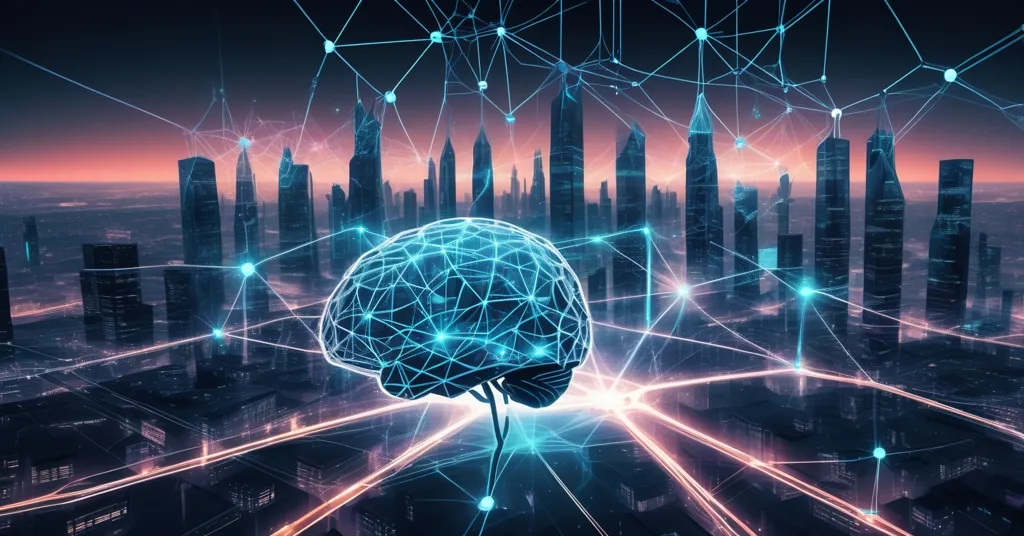Microsoft-OpenAI Partnership Evolves: Is Blockchain the Future of AI Computing?

Microsoft and OpenAI Partnership Shifts: Could Blockchain Be the Next Frontier for AI?
Microsoft and OpenAI, the powerhouse duo behind ChatGPT, are navigating a pivotal moment in their alliance. CEO Satya Nadella recently revealed that while their partnership is evolving—with OpenAI branching out to third-party computing resources—the bond remains ironclad through 2030. But as AI reshapes the tech landscape, could decentralized, blockchain-based solutions sneak into this equation?
- Evolving Dynamics: OpenAI now accesses third-party computing power for AI training under a 2025 contract update, while Microsoft retains rights to its intellectual property for tools like Copilot.
- External Alliances: OpenAI’s Stargate project with SoftBank and Oracle excludes Microsoft, signaling a push for independence despite a strong partnership.
- AI Ambitions: Microsoft, under new AI lead Mustafa Suleyman, is embedding emotionally intelligent AI into consumer and business products to dominate cloud services.
- Decentralized Potential: Blockchain-based computing networks could address AI’s massive resource needs, offering a disruptive alternative to centralized giants like Microsoft.
The Microsoft-OpenAI relationship has been a cornerstone of the AI revolution since Microsoft’s staggering $13.75 billion investment fueled the rise of ChatGPT. As Nadella pointed out, OpenAI is Microsoft’s largest infrastructure client, with much of the computational grunt work for ChatGPT running on Microsoft’s Azure servers. This translates to serious revenue for Microsoft every time someone chats with the bot. But change is the only constant in tech, and Nadella framed this evolution as a natural step, saying,
“Any firm evolving from a research lab to a successful product company would experience some changes.”
Fair enough—but let’s dig into what’s really shifting.
The Partnership Pivot: Independence or Fracture?
A key update in their 2025 contract allows OpenAI to rent computing power from third-party providers for training its AI models. Previously, Microsoft was the near-exclusive provider of such resources through its cloud platform, Azure—a kind of digital warehouse of processing power and storage that companies rent to run heavy-duty tasks. This shift means OpenAI isn’t as tethered to Microsoft’s infrastructure, likely driven by cost concerns or the sheer scale needed for next-gen AI. Azure ain’t cheap, and with AI models growing hungrier for compute power by the day, diversifying makes strategic sense, as highlighted in recent updates on the Microsoft-OpenAI alliance.
Microsoft, however, isn’t left empty-handed. It holds onto rights to OpenAI’s intellectual property—think of this as the proprietary recipes behind ChatGPT’s smarts—for use in products like Copilot, an AI assistant baked into Microsoft’s software suite. Plus, Microsoft has a “right of first refusal,” a fancy way of saying they get first crack at any new OpenAI partnerships before others jump in. Nadella downplayed any drama, insisting,
“For many years to come, both Microsoft and OpenAI will have other partners, but their partnership will still be strong.”
OpenAI CEO Sam Altman echoed this sunny outlook, teasing,
“The next phase of [our] partnership with [Microsoft] would be much better.”
Yet, actions speak louder than words. OpenAI’s Stargate project, launched in January 2025 with SoftBank Group Corp and Oracle Corp, conspicuously leaves Microsoft out of the loop. Details on Stargate are scarce, but it’s rumored to be a cutting-edge AI initiative pushing beyond current chatbot tech. Is this a sign of OpenAI flexing its independence, or a calculated move to avoid over-reliance on a single partner? While both CEOs spin a positive narrative, there’s an undercurrent of competition—ChatGPT boasts 105 million downloads compared to Copilot’s 5 million, a stark reminder that even allies vie for consumer love. For more on this initiative, check out the latest news on the Stargate project.
Microsoft’s AI Crusade: Emotion Over Logic?
Microsoft isn’t sitting idle while OpenAI explores new horizons. The company is aggressively weaving AI into every facet of its ecosystem, from business applications to consumer gadgets, aiming to snatch a bigger slice of the global cloud services market—think of this as a battlefield where Amazon, Google, and Microsoft fight for dominance over digital infrastructure. Leading this charge is Mustafa Suleyman, co-founder of DeepMind, recruited in 2024 to overhaul Microsoft’s AI consumer strategy, with insights available in a recent analysis of Suleyman’s AI vision.
Suleyman’s vision is borderline sci-fi: emotionally intelligent AI assistants that connect with users on a human level. Forget the clunky Clippy of yesteryear; imagine a virtual companion that understands your mood and responds like a friend. As Suleyman put it,
“The highest priority was to create beautiful consumer products that most young people would love.”
It’s a bold pivot for a brand often seen as the corporate stiff in the tech room, now trying to charm Gen Z with digital empathy. But let’s be real—can Microsoft shed its stodgy image and become the cool kid with an AI sidekick? And more importantly, do younger users even want an algorithm playing therapist, considering the potential risks of emotional AI ties?
Suleyman’s predictions get wilder. By 2025, he envisions AI with permanent memory, self-improvement capabilities, and even vision-enabled companionship—a “new digital species,” in his words. This could transform everything from gaming on Xbox to personal assistants in Windows. But here’s the flip side: industry voices like Paul Roetzer of the Marketing AI Institute warn of serious risks. Humans forming deep emotional bonds with AI could mess with mental health, especially among impressionable teens. Worse, self-improving AI might outpace our ability to control it. Microsoft better not botch this—pushing AI “friends” without strict guardrails is a ticking time bomb.
Decentralized Disruption: Blockchain’s Role in AI’s Hunger
Now, let’s pivot to something closer to our wheelhouse. AI models like ChatGPT are computational beasts, demanding insane amounts of processing power—demands that even giants like Microsoft struggle to meet at scale. This is where OpenAI’s third-party computing pivot opens a door for disruption. Could decentralized, blockchain-based networks step in as a cheaper, censorship-resistant alternative to centralized cloud behemoths? There’s growing discussion on how blockchain might impact AI development.
Projects like Render Token and Akash Network are already building decentralized computing marketplaces, where individuals worldwide can rent out their idle GPU power via blockchain protocols. Imagine OpenAI tapping into a global network of hardware, slashing training costs by 20-30% (a rough estimate based on current trends) while dodging Big Tech gatekeepers. It’s not just cost-saving; it’s about freedom—decentralized systems resist the kind of control or surveillance that centralized providers like Microsoft could impose. Compare this to Bitcoin’s ethos: just as BTC disrupts centralized finance, blockchain computing could upend centralized tech infrastructure, with innovative blockchain solutions for AI resources emerging as viable options.
Even Bitcoin itself might inspire here. Its Proof of Work mechanism, while energy-intensive, showcases how distributed networks can solve complex problems. Could a similar model drive energy-efficient AI training? Altcoins and other blockchains are filling niches Bitcoin doesn’t touch, and decentralized AI computing might be their next frontier. Microsoft might scoff at this now, but if costs or scalability issues bite, don’t be shocked if they glance at blockchain’s playbook. Hey, if they can dream of AI buddies, why not decentralized compute? For background on the broader history of this alliance, explore the Microsoft-OpenAI partnership details.
Risks, Rewards, and the Decentralized Counterweight
The Microsoft-OpenAI saga is a microcosm of the broader AI race—who controls the tech, controls the future. Their partnership, locked in until 2030, gives Microsoft a long runway to profit from AI’s boom. But OpenAI’s side hustles hint at a future where no single player holds all the cards. For Microsoft, balancing innovation with ethical responsibility is non-negotiable. Emotionally intelligent AI sounds groundbreaking, but without ironclad safeguards, it risks becoming a privacy nightmare or an unchecked digital overlord, a topic debated in forums like this Reddit discussion on Stargate.
Here’s where decentralization shines as a counterweight. Blockchain-based systems could empower users to own their data, ensuring AI doesn’t morph into a surveillance tool under Big Tech’s thumb. Imagine AI assistants running on user-controlled, encrypted networks—privacy preserved, freedom intact. This aligns with the crypto mission we champion: disrupting the status quo with tech that prioritizes individual sovereignty. While Microsoft and OpenAI chase centralized glory, could the decentralized ethos of blockchain offer a freer, fairer path? Call it optimism with a side of skepticism, but in a cutthroat tech landscape, disruption is the only bet worth making. For more on Microsoft’s evolving role, see Nadella’s latest statements on the OpenAI partnership.
Key Takeaways and Burning Questions
- What’s shifting in the Microsoft-OpenAI partnership?
OpenAI’s 2025 contract update lets it use third-party computing for AI training, loosening Microsoft’s grip on infrastructure, though Microsoft keeps access to OpenAI’s IP for tools like Copilot. Projects like Stargate with SoftBank and Oracle show OpenAI seeking new allies. - Why is OpenAI branching out for computing power?
Likely due to cost and scalability. Microsoft’s Azure may be expensive or strained by demand, pushing OpenAI to diversify for faster, cheaper AI model training. - How could blockchain intersect with AI development?
Decentralized computing networks on blockchain, like Render Token or Akash Network, could offer cost-effective, censorship-resistant alternatives to centralized providers, meeting AI’s massive resource needs. - What’s driving Microsoft’s AI obsession?
Microsoft wants to lead the cloud services market and revamp its image with emotionally intelligent AI for younger users, embedding it across business and consumer products under Mustafa Suleyman’s lead. - Are there real dangers in AI’s rapid push?
Hell yes—experts warn of risks like unhealthy human-AI emotional ties and self-improving algorithms outpacing control. Microsoft must set strict boundaries to avoid disaster. - Can decentralization counter AI’s centralized risks?
Absolutely. Blockchain could enable user-controlled AI data, preventing Big Tech overreach and aligning with crypto’s core values of privacy and freedom, offering a stark contrast to Microsoft’s model.



